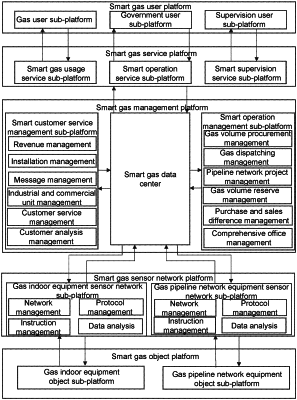| CPC G08B 21/16 (2013.01) [G08B 25/006 (2013.01); H04W 76/50 (2018.02)] | 8 Claims |

|
1. A method for handling an emergency based on a call center of smart gas, performed by a smart gas management platform of an Internet of Things (IoT) system for handling an emergency based on a call center of smart gas, wherein the IoT system for handling the emergency based on the call center of smart gas includes a smart gas user platform and a smart gas service platform, the method comprising:
obtaining information of a gas emergency based on a call answered by the call center of smart gas;
determining severity of the gas emergency based on the information of the gas emergency, wherein the gas emergency is a gas leakage event, and the determining severity of the gas emergency based on the information of the gas emergency includes:
predicting a severity of the gas leakage event through a severity prediction model based on the information of the gas emergency and a real-time monitoring situation of a gas pipeline network, wherein the severity prediction model is a machine learning model, and the severity prediction model includes a leakage prediction layer and a severity prediction layer, wherein an input of the leakage prediction layer includes the information of the gas emergency and the real-time monitoring situation of the gas pipeline network, an output of the leakage prediction layer includes a leakage volume and an affected region, an input of the severity prediction layer includes the leakage volume, an affected region, and environmental information, and an output of the severity prediction layer includes the severity of the gas leakage event;
automatically determining an emergency response plan of the gas emergency based on the information of the gas emergency and the severity of the gas emergency, wherein the automatically determining an emergency response plan of the gas emergency based on the information of the gas emergency and the severity of the gas emergency includes:
predicting, by a gas supply volume prediction model, a gas supply volume of a gas pipeline network in an affected region and a surrounding region based on the information of the gas emergency, wherein the gas supply volume prediction model is a machine learning model;
determining whether the gas supply volume satisfies a preset gas supply volume condition; and
in response to a determination that the gas supply volume does not satisfy the preset gas supply volume condition, determining a gas replenishment plan and prompting a user; and
generating a remote control instruction based on the emergency response plan and sending the remote control instruction to the smart gas service platform, and sending the remote control instruction to the smart gas user platform based on the smart gas service platform to make the smart gas user platform to perform the emergency response plan.
|